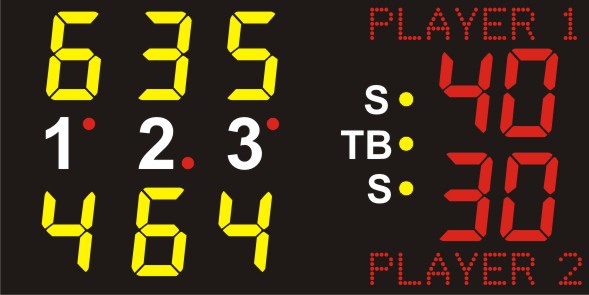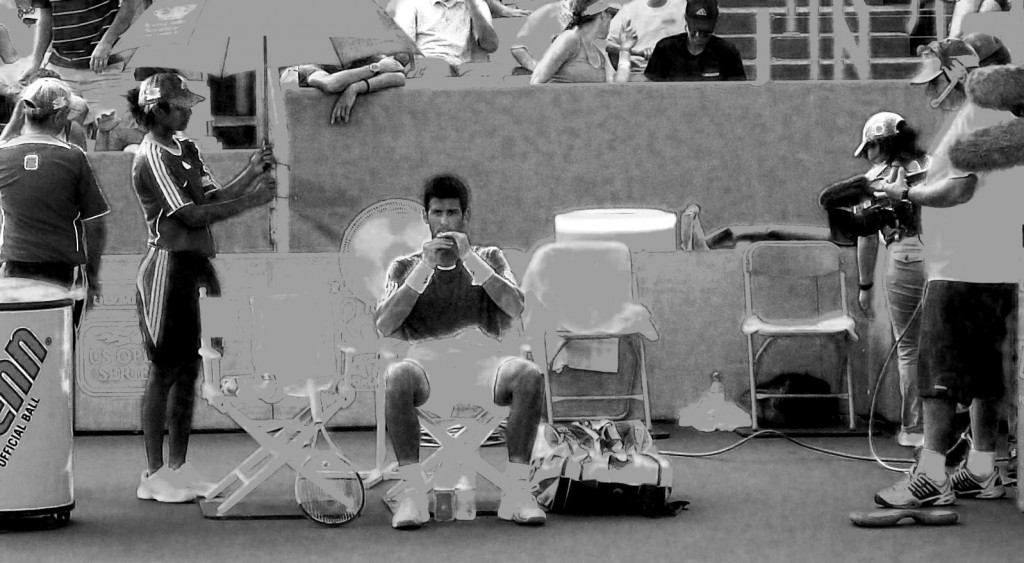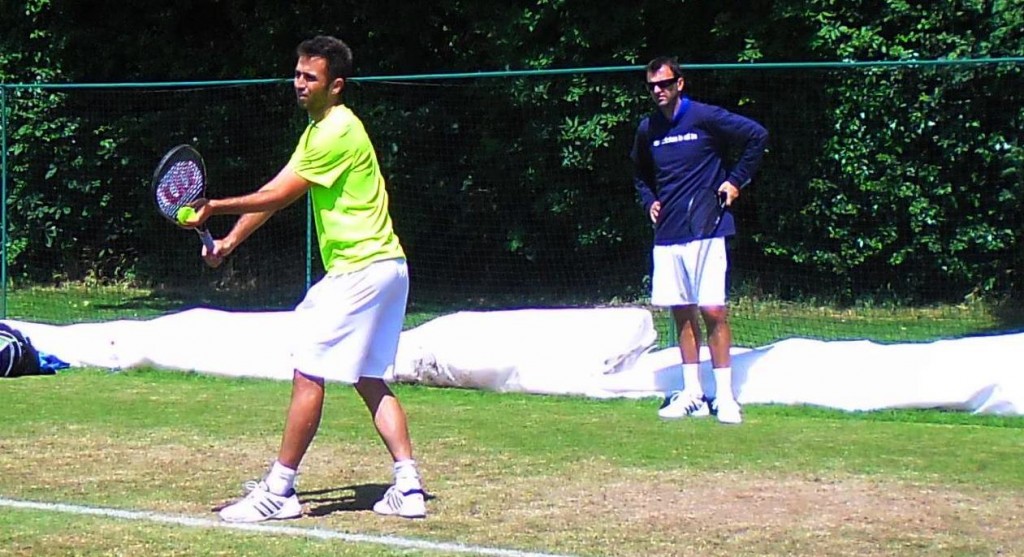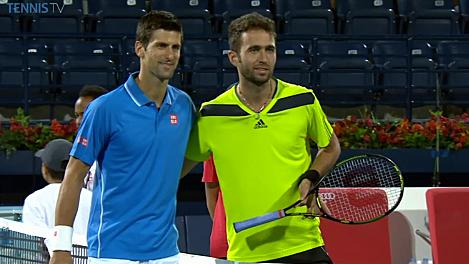Prior to the start of Sunday, most tennis fans had high expectations of the fourth-round matches on the men’s side. But it was not until the end of the third set of the Nick Kyrgios vs. Andres Seppi that the excitement finally surfaced. The first two matches, Bernard Tomic vs. Tomas Berdych and Rafael Nadal vs. Kevin Anderson finished in anti-climactic fashion. You could almost write the scenario of Nadal vs. Anderson match prior to its beginning, and it remained loyal to that scenario. Anderson’s strengths played into Nadal’s hands, and baseline rallies ensued in which Rafa did everything better than his opponent, and won convincingly as expected. However, Tomic vs. Berdych could have been – should have been – handled more astutely by Tomic.
The young Aussie came into the match playing perhaps the best tennis of his career, and had the necessary skills to startle Berdych. He possesses the ability to flatten out his forehand, push his opponent around, approach the net, as well as win a slew of free points with his awkward-looking-yet-effective serve. What Tomic seems to have forgotten to do, quite stunningly for a player at his level, was to come out with a game plan. The Tomic camp overlooked one of the most underrated areas of tennis tactics: how to come out of the gates.
The match began with Tomic’s serve. From the first point on, for some odd reason, Tomic stayed at the baseline, rallied and obeyed Berydch’s plan A. The result is that Tomic made three unforced errors on the forehand, Berdych pushed him around on another rally, and broke Tomic’s serve to start the match. When the Czech followed that game with three aces of his own to go up 2-0, Tomic, again oddly, stayed the course with the same tactic of rallying at the baseline. Consequently, Berdych took a 4-0 lead in fifteen minutes. By that time, Berdych beamed with confidence, worked his monster ground strokes and served aces and service winners left and right. Tennis coaches often say “It’s better to have a bad game plan than no plan at all.” That cliché could not have been more accurate in this case. Tomic seemed to have spent the entire first set figuring out what to do next. In 27 minutes, Berdych won the set 6-2 having committed three more unforced errors (11) than Tomic (8). On paper it may raise an eyebrow, but Tomic committing less unforced errors than Berdych is a bad sign for Tomic, not for Berdych. It showed how passive Tomic played throughout the set.
The first game of the second set was indicative of what Tomic needed to do from the beginning of the match. At 15-30 serving, Tomic served a big serve and earned a short return from Berdych. Instead of rushing Berdych and coming to the net, he inexplicably contented with putting the ball back in play. Three points later at deuce, he got the same type of short ball, and this time, hit his forehand with a purpose, forcing Berdych into an error. When he held that game to go up 1-0, it looked like he finally figured out that he could not rally with the Czech from the baseline, that he needed to keep the points short and not let Berdych have the first shot at target practice during rallies. Tomic did just that in the ensuing games with renewed confidence, and Berdych began to feel the pressure. The Czech forced some shots to keep Tomic from unleashing shot after shot. It resulted in him making a number of “forced” errors, and eventually, the match leveled. Again, it was the early games of that set that established the tone.
The problem remained that Tomic now had to play catch-up, down a set. And when you play catch-up against an experienced top-10 player, there is no room for blunders and every point becomes crucial because that second set is vital to having a chance to win. Despite a much better set by Tomic, Berdych played an impeccable tiebreaker to take a 6-2 7-6 lead, effectively shutting the door on Tomic. Third set was just the countdown to the inevitable.
The lesson from this match: you must come out with a game plan. The underlying message: do not underestimate the underrated importance of the first games in any set. Regular readers and my friends have heard me say this numerous times before: sets are won or lost in the first few games. Nobody remembers the 15-30 1-0 point, or the deuce point in the first game (à la Ivan Lendl did with his computer brain), and often focus on a set point at 6-5 or the 5-5 point in the tiebreaker. Then the clichés resurface: “A point here and there on big points at late stages, and the outcome would have been different!” First question should rather be “How did it get there?” The answer often lies in the first couple of games where momentum swings occur and set the tone for the later games in the set.
The Kyrgios vs. Seppi match provided an emblematic example of this underrated aspect, for anyone that cares to remember the early points of the third set.
This match was the featured event of the night. What it lacked in quality of tennis, it made up for in excitement. The score line was dramatic, and it pitted the player who upset Roger Federer against the most exciting youngster in the ATP in front of his home crowd at the Hisense Arena. I will refrain from doing a lengthy analysis of the match (there are plenty around the web) and center on the first two games of the third set which, in my opinion, played a paramount role in the improbable comeback of Kyrgios. Once again, people will remember, the match point in the fourth set, the crucial point or two at 6-5 and 6-6 in the fifth, and talk about them. But none of that would have taken place if Seppi did not serve the first two games of the third set on a golden platter to Kyrgios.
At 7-5 6-4, Seppi had complete control of the match, and generated more winners from both sides and served more aces than Kyrgios (who would have guessed that?!?!). More importantly, his performance had quietened the crowd and seemed to sap Kyrgios’ spirit. Uncharacteristically, the Italian veteran had a let-down. Either he felt that he had the match in his pocket and relaxed, or simply lost his concentration. In any case, he played the two loosest games of his Australian Open adventure, did not move well, and lacked intensity and determination. He spat out seven unforced errors in two games, four of them coming in the second game where he got broken to give – and I don‘t use the verb ‘give’ lightly here – Kyrgios the 2-0 lead. Just like that, Kyrgios held to go up 3-0. Seppi gave Kyrgios a shot of renewed belief and energy that he masterfully sucked out of him for two sets. But Kyrgios was not the only energized. The break also galvanized the Hisense Arena fans that were desperately looking for something to cheer. They began to feed Kyrgios a steady stream of loud cheers and banging noises on the walls, seats, and anything else they could find on which to tap their hands. It is no secret that any player can feed off the crowd support. But Kyrgios is a different horse in this category. He savors the crowd; he communicates and teams up with them. He pumps them up, they pump him up! All of a sudden, Kyrgios looked determined in his demeanor. He began to pierce his groundstrokes, pressuring Seppi, and serving bigger and better. Doubts began to creep in Seppi’s mind and he began to falter on his ground strokes that have previously clicked on all cylinders.
When the first set was over, Seppi knew that this was now a much different match than the first two sets. Yes, not capitalizing on match point in the fourth set did not help. Yes, not daring to go for the short ball on Kyrgios’ return on the last point of the match did not help. Yes, Kyrgios’ improved serve in the last two sets did not help. However, none of those late “key” points were momentum changers. Everything that happened in the last three sets were the end-product of the momentum change from the first two games of the third set. Seppi had the match in his hands, did not put it away. I would argue that he had the match “in his hands” more at 7-5 6-4 than when he had the match point.
Coaches of today: spend time with your young pupils in front of the TV and make them watch professional matches from the first point to the last. More importantly, discuss and analyze as the match progresses, stimulate their minds to the importance of the early games. I see too often junior players beginning their matches with low intensity, playing the first games of the match, or even the early games of the next set, as if they were the continuation of the five-minute warm-up. They are not! Tomic and Seppi can tell you more if you run into them.
 Yes, this point is important, but how did it get there? (Image: Movitec Electronics)
Yes, this point is important, but how did it get there? (Image: Movitec Electronics)
Note: Follow MT-Desk on Tweeter throughout the Australian Open: @MertovsTDesk





